Compressive Behaviour of Closed-Cell Aluminium Foam at Different Strain Rates
Abstract
:1. Introduction
2. Fabrication of Specimens and Experimental Methods
3. Experimental Results
3.1. Quasi-Static Testing
3.2. High Strain Rate Testing
3.3. The Specific Energy Absorption Analysis
4. Computational Simulations
4.1. Computational Model
4.2. Computational Results and Comparison with the Experimental Observations
4.3. High Strain Rate Behaviour Analysis
5. Conclusions
Author Contributions
Funding
Conflicts of Interest
References
- Gibson, L.J.; Ashby, M.F. Cellular Solids: Structure and Properties, 2nd ed.; Cambridge University Press: Cambridge, UK, 1997. [Google Scholar]
- Ashby, M.F.; Evans, A.; Fleck, N.; Gibson, L.J.; Hutchinson, J.W.; Wadley, H.N. Metal Foams: A Design Guide; Elsevier Science: Burlington, MA, USA, 2000. [Google Scholar] [CrossRef]
- Lehmhus, D.; Vesenjak, M.; de Schampheleire, S.; Fiedler, T. From stochastic foam to designed structure: Balancing cost and performance of cellular metals. Materials 2017, 10, 922. [Google Scholar] [CrossRef] [PubMed] [Green Version]
- Banhart, J. Light-metal foams—History of innovation and technological challenges. Adv. Eng. Mater. 2013, 15, 82–111. [Google Scholar] [CrossRef]
- Körner, C. Additive manufacturing of metallic components by selective electron beam melting—A review. Int. Mater. Rev. 2016, 61, 361–377. [Google Scholar] [CrossRef] [Green Version]
- Bauer, J.; Meza, L.R.; Schaedler, T.A.; Schwaiger, R.; Zheng, X.; Valdevit, L. Nanolattices: An Emerging Class of Mechanical Metamaterials. Adv. Mater. 2017, 29, 1–26. [Google Scholar] [CrossRef]
- Duarte, I.; Peixinho, N.; Andrade-campos, A.; Valente, R. Special Issue on Cellular Materials. Sci. Technol. Mater. 2018, 30, 1–3. [Google Scholar] [CrossRef]
- Elsayed, H.; Rebesan, P.; Giacomello, G.; Pasetto, M.; Gardin, C.; Ferroni, L.; Zavan, B.; Biasetto, L. Direct ink writing of porous titanium (Ti6Al4V) lattice structures. Mater. Sci. Eng. C 2019, 103, 1–9. [Google Scholar] [CrossRef]
- Baumgärtner, F.; Duarte, I.; Banhart, J. Industrialization of Powder Compact Toaming Process. Adv. Eng. Mater. 2000, 2, 168–174. [Google Scholar] [CrossRef]
- Duarte, I.; Vesenjak, M.; Vide, J.M. Automated Continuous Production Line of Parts Made of Metallic Foams. Metals 2019, 9, 531. [Google Scholar] [CrossRef] [Green Version]
- Degischer, H.P.; Kriszt, B. Handbook of Cellular Metals; Wiley-VCH: Weinheim, Germany, 2002. [Google Scholar]
- Barletta, M.; Guarino, S.; Montanari, R.; Tagliaferri, V. Metal foams for structural applications: Design and manufacturing. Int. J. Comput. Integr. Manuf. 2007, 20, 497–504. [Google Scholar] [CrossRef]
- Barletta, M.; Gisario, A.; Guarino, S.; Rubino, G. Production of Open Cell Aluminum Foams by Using the Dissolution and Sintering Process (DSP). J. Manuf. Sci. Eng. 2009, 131, 1–10. [Google Scholar] [CrossRef]
- Duarte, I.; Vesenjak, M.; Krstulović-Opara, L. Compressive behaviour of unconstrained and constrained integral-skin closed-cell aluminium foam. Compos. Struct. 2016, 154, 231–238. [Google Scholar] [CrossRef]
- Duarte, I.; Krstulović-Opara, L.; Vesenjak, M. Characterisation of aluminium alloy tubes filled with aluminium alloy integral-skin foam under axial compressive loads. Compos. Struct. 2015, 121, 154–162. [Google Scholar] [CrossRef]
- Duarte, I.; Vesenjak, M.; Krstulović-Opara, L. Dynamic and quasi-static bending behaviour of thin-walled aluminium tubes filled with aluminium foam. Compos. Struct. 2014, 109, 48–56. [Google Scholar] [CrossRef]
- Duarte, I.; Vesenjak, M.; Krstulović-Opara, L.; Ren, Z. Static and dynamic axial crush performance of in-situ foam-filled tubes. Compos. Struct. 2015, 124, 128–139. [Google Scholar] [CrossRef]
- Peroni, L.; Avalle, M.; Peroni, M. The mechanical behaviour of aluminium foam structures in different loading conditions. Int. J. Impact. Eng. 2008, 35, 644–658. [Google Scholar] [CrossRef]
- Ulbin, M.; Vesenjak, M.; Borovinšek, M.; Duarte, I.; Higa, Y.; Shimojima, K.; Ren, Z. Detailed Analysis of Closed-Cell Aluminum Alloy Foam Internal Structure Changes during Compressive Deformation. Adv. Eng. Mater. 2018, 8, 1–8. [Google Scholar] [CrossRef]
- Novak, N.; Hokamoto, K.; Vesenjak, M.; Ren, Z. Mechanical behaviour of auxetic cellular structures built from inverted tetrapods at high strain rates. Int. J. Impact. Eng. 2018, 122, 83–90. [Google Scholar] [CrossRef]
- Islam, M.A.; Brown, A.D.; Hazell, P.J.; Kader, M.A.; Escobedo, J.P.; Saadatfar, M.; Xu, S.; Ruan, D.; Turner, M. Mechanical response and dynamic deformation mechanisms of closed-cell aluminium alloy foams under dynamic loading. Int. J. Impact. Eng. 2018, 114, 111–122. [Google Scholar] [CrossRef]
- Deshpande, V.S.; Fleck, N.A. High strain rate compressive behaviour of aluminium alloy foams. Int. J. Impact. Eng. 2000, 24, 277–298. [Google Scholar] [CrossRef] [Green Version]
- Zheng, Z.; Yu, J.; Wang, C.; Liao, S.; Liu, Y. Dynamic crushing of cellular materials: A unified framework of plastic shock wave models. Int. J. Impact. Eng. 2013, 53, 29–43. [Google Scholar] [CrossRef]
- Liu, X.; Zhang, J.; Fang, Q.; Wu, H.; Zhang, Y. Response of closed-cell aluminum foams under static and impact loading: Experimental and mesoscopic numerical analysis. Int. J. Impact. Eng. 2017, 110, 382–394. [Google Scholar] [CrossRef]
- Duarte, I.; Vesenjak, M.; Krstulović-Opara, L. Variation of quasi-static and dynamic compressive properties in a single aluminium foam block. Mater. Sci. Eng. A 2014, 616, 171–182. [Google Scholar] [CrossRef]
- Vesenjak, M.; Veyhl, C.; Fiedler, T. Analysis of anisotropy and strain rate sensitivity of open-cell metal foam. Mater. Sci. Eng. A 2012, 541, 105–109. [Google Scholar] [CrossRef]
- Fang, Q.; Zhang, J.; Zhang, Y.; Liu, J.; Gong, Z. Mesoscopic investigation of closed-cell aluminum foams on energy absorption capability under impact. Compos. Struct. 2015, 124, 409–420. [Google Scholar] [CrossRef]
- Fang, Q.; Zhang, J.; Zhang, Y.; Wu, H.; Gong, Z. A 3D mesoscopic model for the closed-cell metallic foams subjected to static and dynamic loadings. Int. J. Impact. Eng. 2015, 82, 103–112. [Google Scholar] [CrossRef]
- Wang, S.; Ding, Y.; Wang, C.; Zheng, Z.; Yu, J. Dynamic material parameters of closed-cell foams under high-velocity impact. Int. J Impact. Eng. 2017, 99, 111–121. [Google Scholar] [CrossRef]
- Sun, Y.; Li, Q.M.; Lowe, T.; McDonald, S.A.; Withers, P.J. Investigation of strain-rate effect on the compressive behaviour of closed-cell aluminium foam by 3D image-based modelling. Mater. Des. 2016, 89, 215–224. [Google Scholar] [CrossRef]
- Xi, C.Q.; Li, Q.M. Meso-scale mechanism of compaction shock propagation in cellular materials. Int. J. Impact. Eng. 2017, 109, 321–334. [Google Scholar] [CrossRef]
- Xu, A.; Vodenitcharova, T.; Kabir, K.; Flores-Johnson, E.A.; Hoffman, M. Finite element analysis of indentation of aluminium foam and sandwich panels with aluminium foam core. Mater. Sci. Eng. A 2014, 599, 125–133. [Google Scholar] [CrossRef]
- Novak, N.; Vesenjak, M.; Ren, Z. Crush behaviour of auxetic cellular structures. Sci. Technol. Mater. 2018, 30, 4–7. [Google Scholar] [CrossRef]
- Yang, P.; Shams, S.S.; Slay, A.; Brokate, B.; Elhajjar, R. Evaluation of temperature effects on low velocity impact damage in composite sandwich panels with polymeric foam cores. Compos. Struct. 2015, 129, 213–223. [Google Scholar] [CrossRef]
- Yang, C.; Kyriakides, S. Multiaxial crushing of open-cell foams. Int. J. Solids. Struct. 2019, 159, 239–256. [Google Scholar] [CrossRef]
- Gaitanaros, S.; Kyriakides, S.; Kraynik, A.M. On the crushing response of random open-cell foams. Int. J. Solids Struct. 2012, 49, 2733–2743. [Google Scholar] [CrossRef] [Green Version]
- Gaitanaros, S.; Kyriakides, S. On the effect of relative density on the crushing and energy absorption of open-cell foams under impact. Int. J. Impact. Eng. 2015, 82, 3–13. [Google Scholar] [CrossRef] [Green Version]
- Sun, Y.; Li, Q.M. Dynamic compressive behaviour of cellular materials: A review of phenomenon, mechanism and modelling. Int. J. Impact. Eng. 2018, 112, 74–115. [Google Scholar] [CrossRef] [Green Version]
- Xiao, L.; Song, W.; Wang, C.; Tang, H.; Fan, Q.; Liu, N.; Wang, J. Mechanical properties of open-cell rhombic dodecahedron titanium alloy lattice structure manufactured using electron beam melting under dynamic loading. Int. J. Impact. Eng. 2017, 100, 75–89. [Google Scholar] [CrossRef]
- Tan, P.J.; Reid, S.R.; Harrigan, J.J.; Zou, Z.; Li, S. Dynamic compressive strength properties of aluminium foams. Part I—Experimental data and observations. J. Mech. Phys. Solids 2005, 53, 2174–2205. [Google Scholar] [CrossRef]
- Tan, P.J.; Reid, S.R.; Harrigan, J.J.; Zou, Z.; Li, S. Dynamic compressive strength properties of aluminium foams. Part II—“shock” theory and comparison with experimental data and numerical models. J. Mech. Phys. Solids 2005, 53, 2206–2230. [Google Scholar] [CrossRef]
- ISO 13314:2011—Mechanical Testing of Metals—Ductility Testing—Compression Test for Porous and Cellular Metals; ISO: Geneva, Switzerland, 2011.
- Tanaka, S.; Hokamoto, K.; Irie, S.; Okano, T.; Ren, Z.; Vesenjak, M.; Itoh, S. High-velocity impact experiment of aluminum foam sample using powder gun. Meas. J. Int. Meas. Confed. 2011, 44, 2185–2189. [Google Scholar] [CrossRef]
- Hipke, T.; Lange, G.; Poss, R. Taschenbuch für Aluminiumschäume; Aluminium-Verlag: Düsseldorf, Germany, 2007. [Google Scholar]
- Krstulović-Opara, L.; Vesenjak, M.; Duarte, I.; Ren, Z. Infrared thermography as a method for energy absorption evaluation of metal foams. Mater. Today Proc. 2016, 3, 1025–1030. [Google Scholar] [CrossRef]
- Abaqus User’s Manual; Dassault Systémes Simulia Corp: Warwick, RI, USA, 2013. [CrossRef]
- Gibson, L.J.; Ashby, M.F. The mechanics of 2D cellular material. Proc. R. Soc. 1982, 382, 25–45. [Google Scholar] [CrossRef]
- Borovinšek, M.; Vesenjak, M.; Ren, Z. Estimating the base material properties of sintered metallic hollow spheres by inverse engineering procedure. Mech. Mater. 2016, 100, 22–30. [Google Scholar] [CrossRef]
- Reid, S.R.; Peng, C. Dynamic uniaxial crushing of wood. Int. J. Impact. Eng. 1997, 19, 531–570. [Google Scholar] [CrossRef]
- El Mouatasim, A.; Ellaia, R.; Souza De Cursi, E. Stochastic perturbation of reduced gradient & GRG methods for nonconvex programming problems. Appl. Math. Comput. 2014, 226, 198–211. [Google Scholar] [CrossRef]
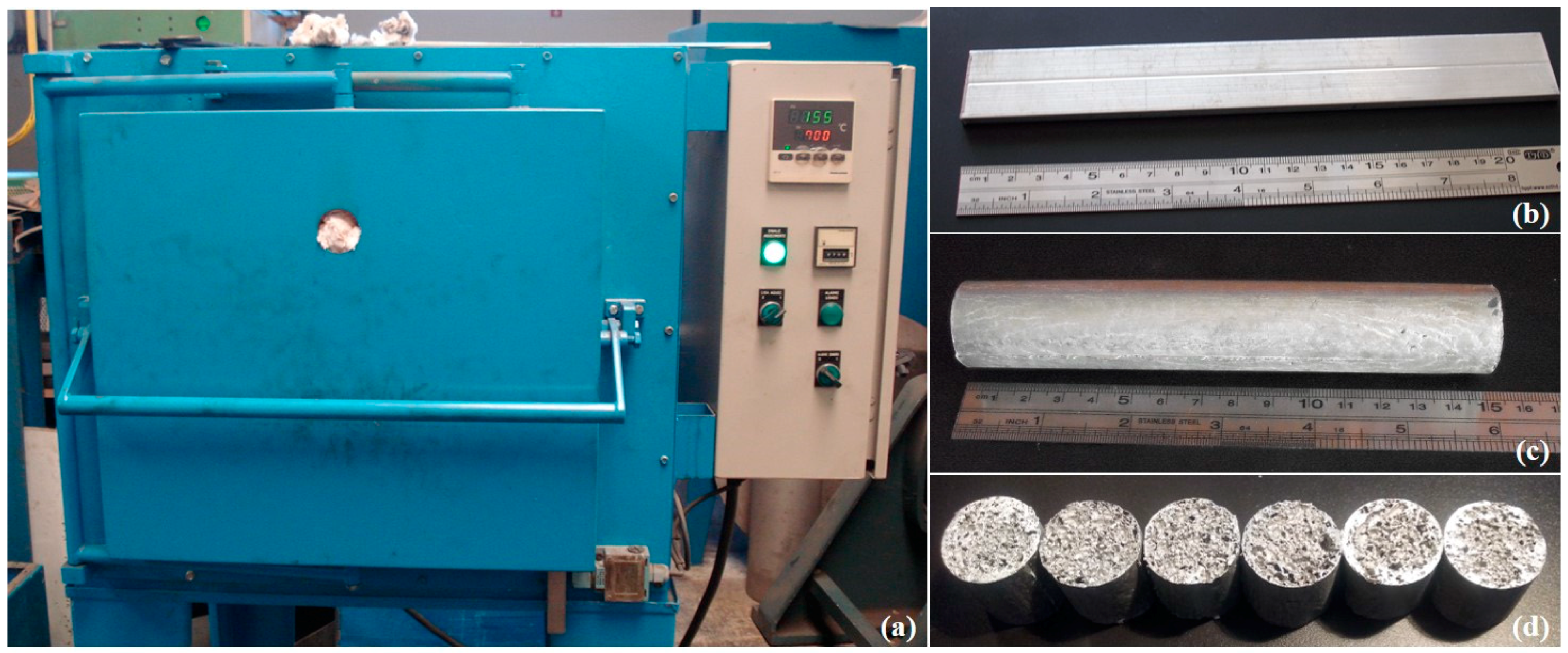

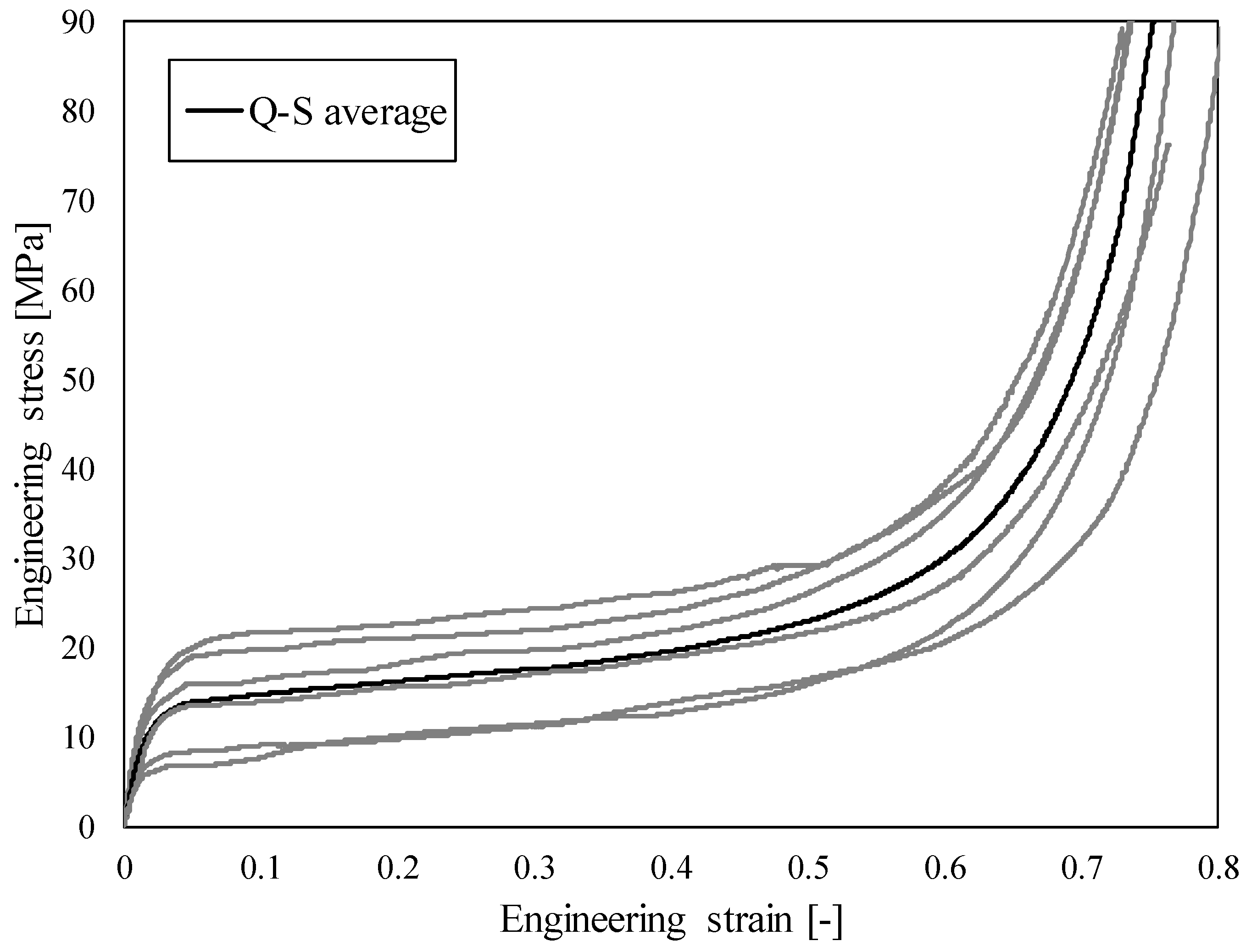

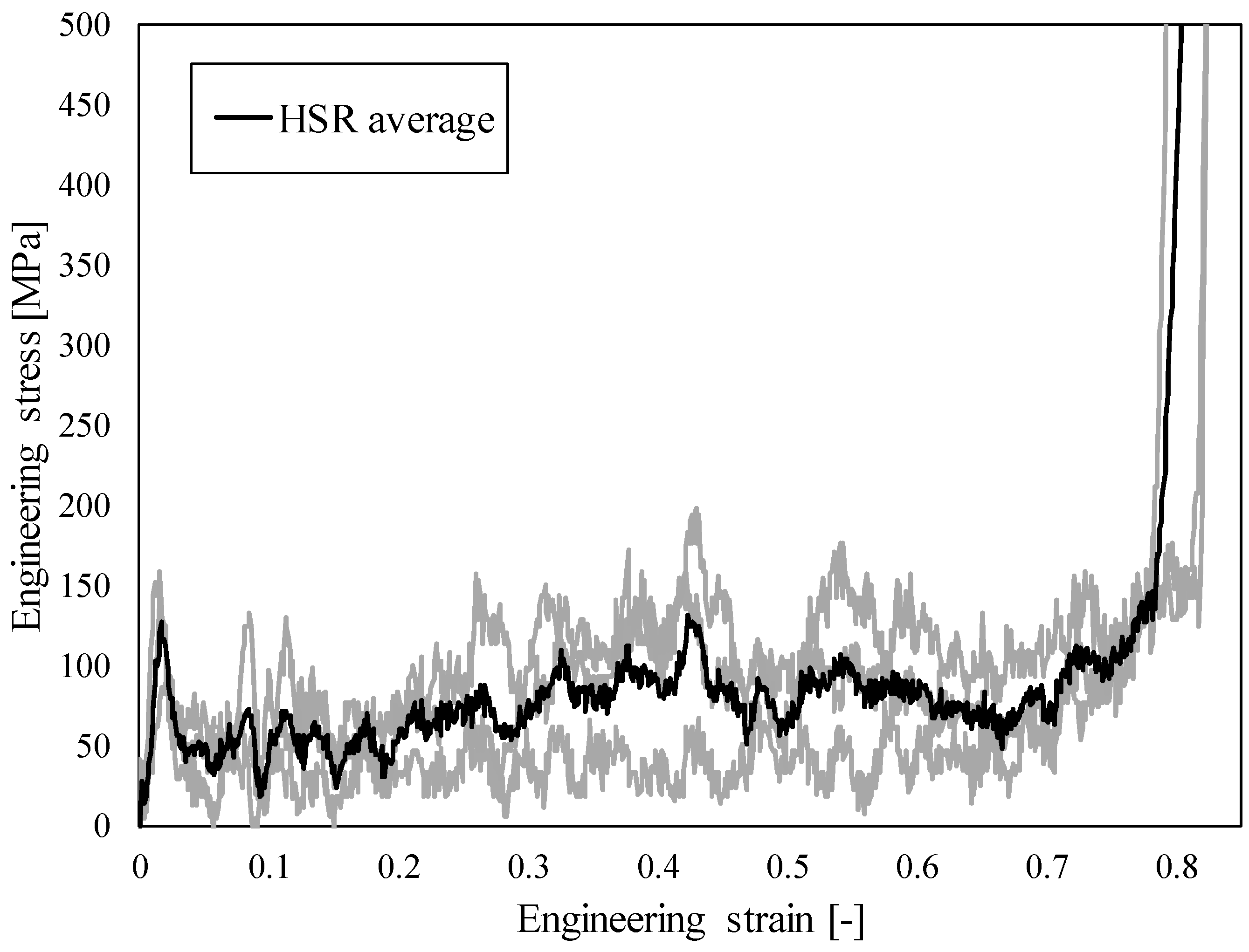

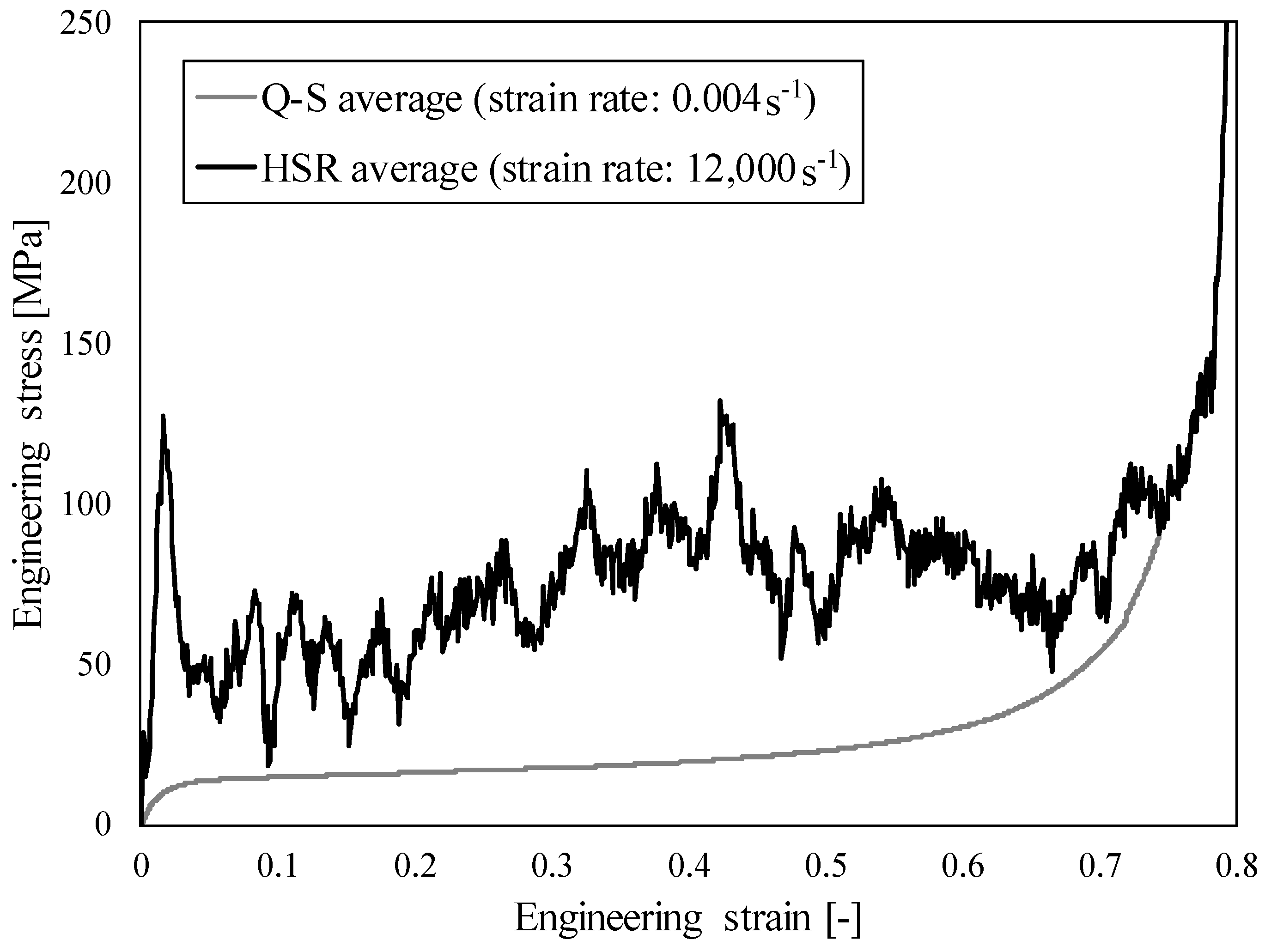
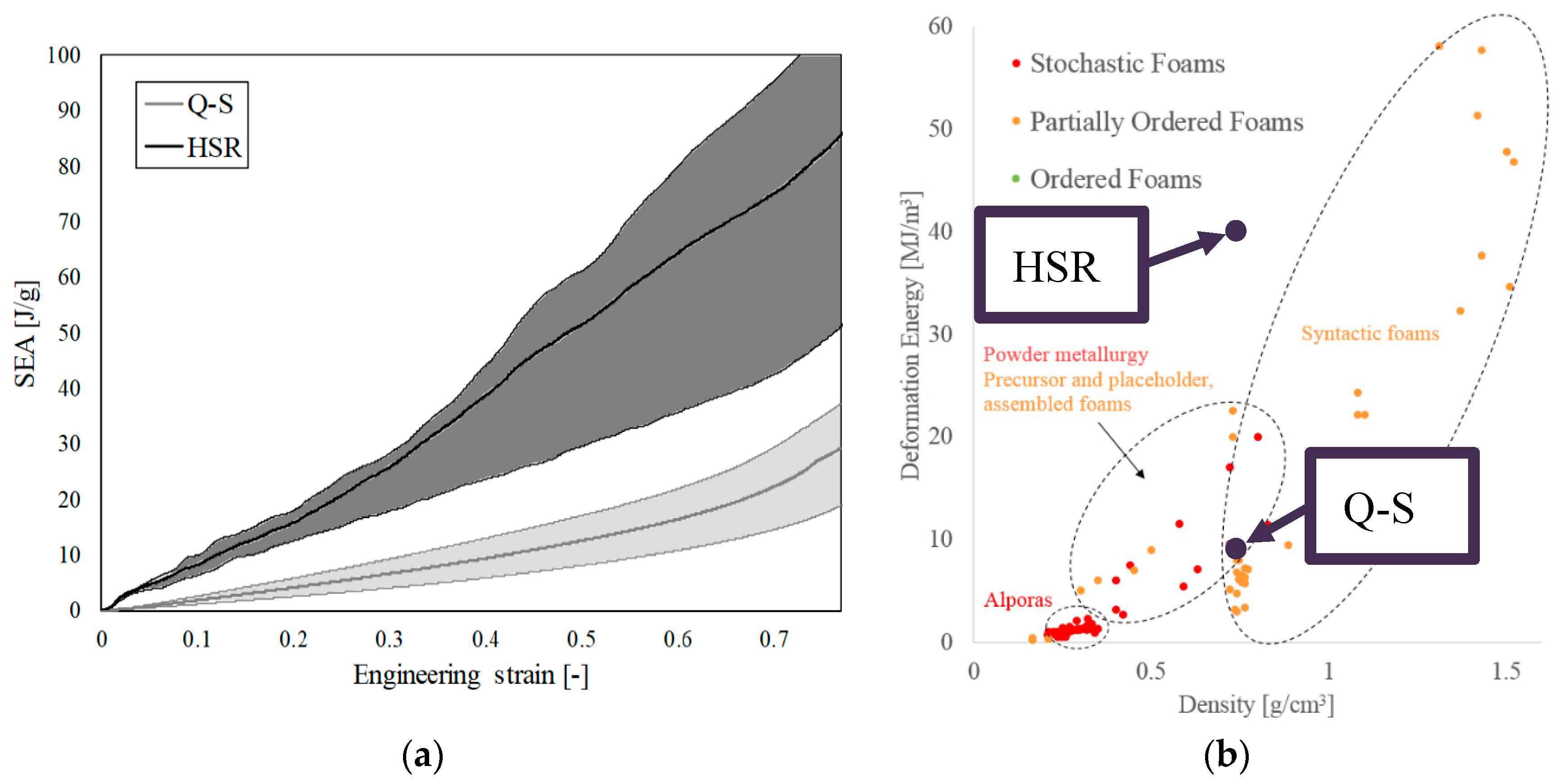

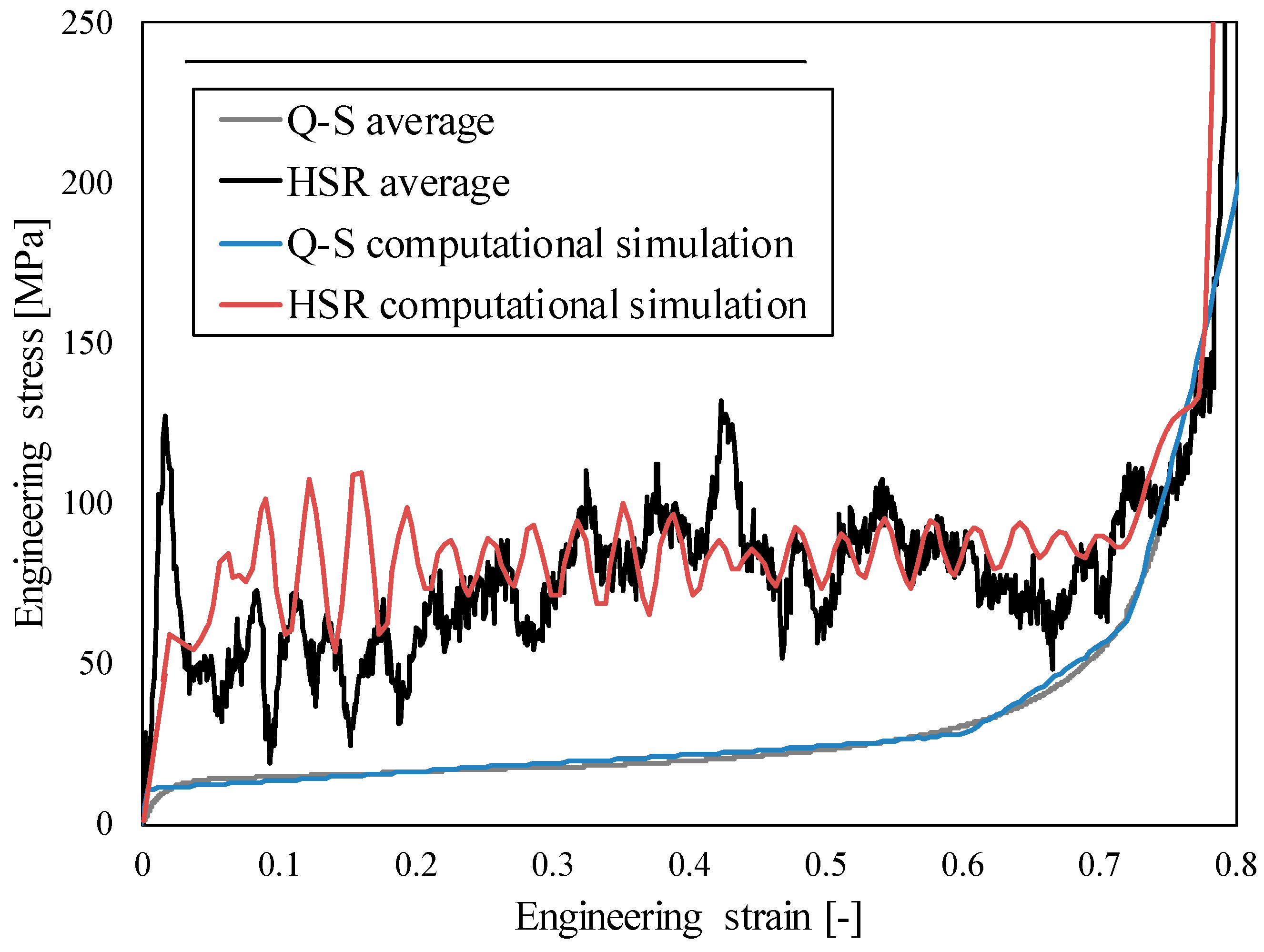



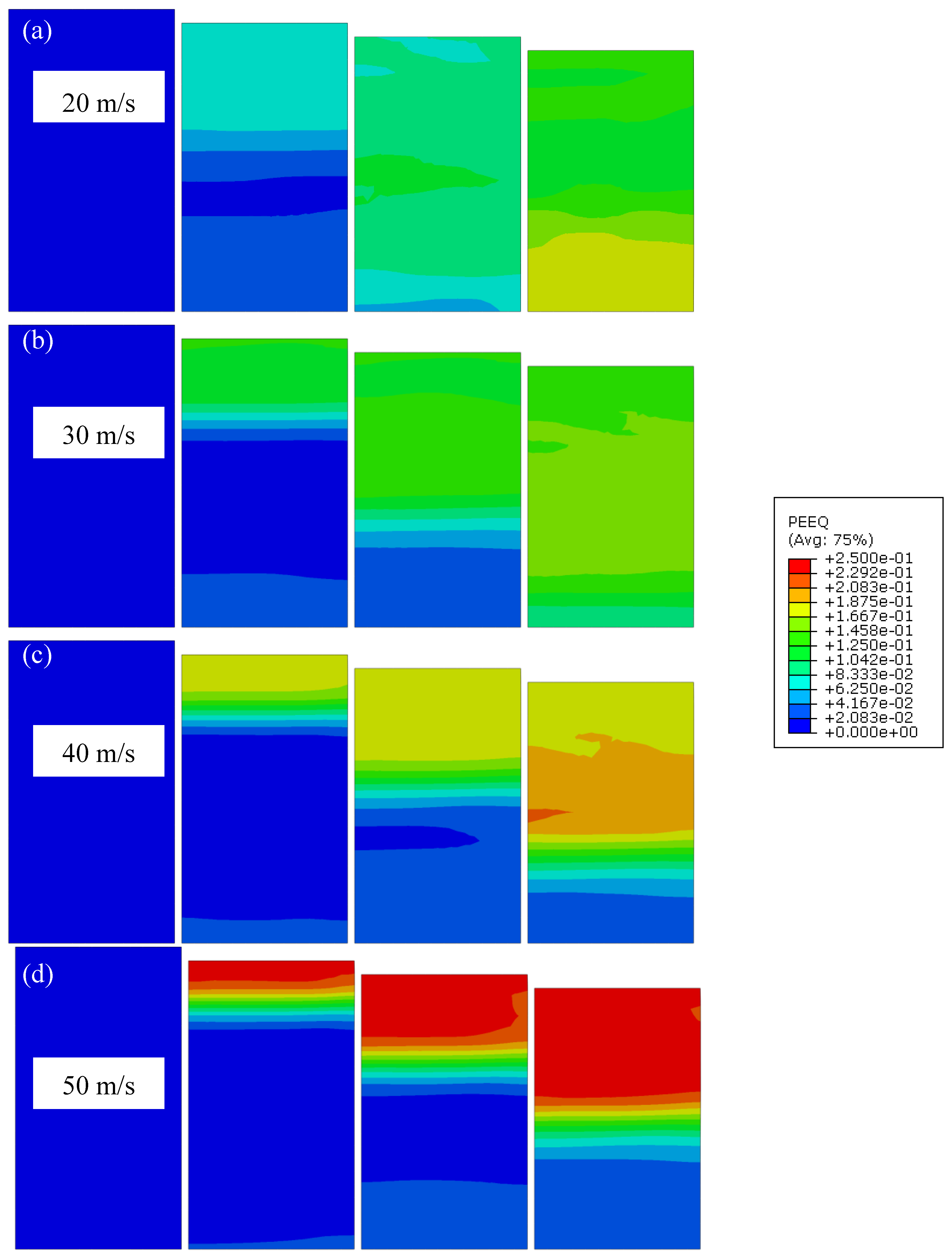
| Diameter | Length | Weight | Density | Porosity | Number of Specimens | |
|---|---|---|---|---|---|---|
| d [mm] | l [mm] | m [g] | ρ [kg/m3] | p [%] | Q-S Testing | HSR Testing |
| 25.32 (0.15) | 23.08 (0.23) | 7.9 (0.39) | 681 (0.03) | 75 | 5 | 3 |
| Loading Velocity Regime | SEA at 50% [J/g] | SEA at 77% [J/g] |
|---|---|---|
| Quasi-static | 13.04 | 29.27 |
| High strain rate | 58.74 | 85.39 |
| ρ [kg/m3] | E [MPa] | ν [–] | k [–] | kt [–] |
|---|---|---|---|---|
| 681 | 5023.8 | 0.11 | 1.53 | 0.45 |
| Pl. Strain [–] | 0 | 0.03 | 0.12 | 0.15 | 0.25 | 0.42 | 0.51 | 0.60 | 0.9 | 1.07 | 1.8 |
|---|---|---|---|---|---|---|---|---|---|---|---|
| Stress [MPa] | 11 | 11.9 | 15.35 | 16.12 | 18.39 | 20.93 | 23.05 | 25.18 | 29.70 | 69.82 | 2100 |
| Porosity φ [–] | σ0 [MPa] | K [MPa] | n [–] | εd [–] | vcr1 [m/s] | vcr2 [m/s] |
|---|---|---|---|---|---|---|
| 0.75 | 18.1 | 595.7 | 7.7 | 0.5 | 37.5 | 46.1 |
© 2019 by the authors. Licensee MDPI, Basel, Switzerland. This article is an open access article distributed under the terms and conditions of the Creative Commons Attribution (CC BY) license (http://creativecommons.org/licenses/by/4.0/).
Share and Cite
Novak, N.; Vesenjak, M.; Duarte, I.; Tanaka, S.; Hokamoto, K.; Krstulović-Opara, L.; Guo, B.; Chen, P.; Ren, Z. Compressive Behaviour of Closed-Cell Aluminium Foam at Different Strain Rates. Materials 2019, 12, 4108. https://doi.org/10.3390/ma12244108
Novak N, Vesenjak M, Duarte I, Tanaka S, Hokamoto K, Krstulović-Opara L, Guo B, Chen P, Ren Z. Compressive Behaviour of Closed-Cell Aluminium Foam at Different Strain Rates. Materials. 2019; 12(24):4108. https://doi.org/10.3390/ma12244108
Chicago/Turabian StyleNovak, Nejc, Matej Vesenjak, Isabel Duarte, Shigeru Tanaka, Kazuyuki Hokamoto, Lovre Krstulović-Opara, Baoqiao Guo, Pengwan Chen, and Zoran Ren. 2019. "Compressive Behaviour of Closed-Cell Aluminium Foam at Different Strain Rates" Materials 12, no. 24: 4108. https://doi.org/10.3390/ma12244108





